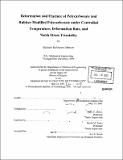Deformation and fracture of polycarbonate and rubber-modified polycarbonate under controlled temperature, deformation rate, and notch stress triaxiality
Author(s)
Johnson, Michael DeShawn, 1977-
DownloadFull printable version (33.49Mb)
Other Contributors
Massachusetts Institute of Technology. Dept. of Mechanical Engineering.
Advisor
Mary C. Boyce and David M. Parks.
Terms of use
Metadata
Show full item recordAbstract
The deformation and fracture of polycarbonate and polycarbonate toughened with methyl-methacrylate shell/polybutadiene core sub-micron particles are investigated. The effects of strain rate, temperature, and notch stress triaxiality on deformation and fracture are studied. The Arruda-Boyce constitutive model for glassy polymers and finite element simulations are used to simulate the deformation of the polycarbonate homopolymer subjected to compression and tension under un-notched and notched conditions. Compression of polycarbonate in uniaxial compression is found to exhibit an initially elastic response followed by yield, then strain softening and strain hardening at large strains. The yield stress is found to be dependent on temperature and strain rate. Yield stress is shown to increase with increasing strain rate and decrease with increasing temperature. Load-displacement behavior of un-notched polycarbonate is shown to exhibit an initially elastic response followed by macroscopic yield, then a load drop, and then a load plateau as the neck stably propagates, soon after the neck has propagated the full length of the specimen it begins to travel into the grip region, ductile failure occurs due to extensive stretching. The fracture is surface initiated. The load at yield is shown to be dependent on temperature and displacement rate. The load at yield increases with increasing strain rate and decreases with increasing temperature. Notched tension specimens are shown to exhibit an initially elastic behavior. Mildly notched specimens tested at room temperature are shown to fail in a ductile manner similar to un-notched specimens. More severely notched specimens, and the moderately notched specimen tested at 100° C are shown to fail in a brittle manner where the brittle failure is found to be internally initiated. The un-notched and notched tension test data together with simulation results enabled construction of ductile and brittle fracture criteria. A ductile failure criterion of maximum strain is proposed. This maximum strain is seen in the ductile failures of both the un-notched and the mildly notched specimens and has a value of approximately 0.65. A temperature dependent brittle failure criterion is proposed. This brittle failure criterion establishes critical values of negative pressure for brittle failure at various temperatures. Rubber-modified compression and tension specimens are shown to exhibit stress-strain and load-displacement behavior similar to that seen for the un-modified material compression and tension tests respectively. The elastic modulus, yield stress, amount of strain softening, and strain hardening are all seen to decrease with increasing rubber volume content. The inclusion of sub-micron rubber particles is shown not to dramatically enhance the mechanical properties of un-notched or mildly notched specimens. The inclusion of sub-micron rubber particles is shown to drastically increase the displacement to failure of more severely notched specimens tested at room temperature, but is shown to provide little improvement for tests conducted at -60° C.
Description
Thesis (S.M.)--Massachusetts Institute of Technology, Dept. of Mechanical Engineering, 2001. Includes bibliographical references (leaves 217-220).
Date issued
2001Department
Massachusetts Institute of Technology. Department of Mechanical EngineeringPublisher
Massachusetts Institute of Technology
Keywords
Mechanical Engineering.